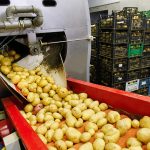Krishak Bharati Cooperative Ltd (KRIBHCO) has joined an agreement with Farm Frites from the Netherlands to set up the potato processing facility located in Shahjahanpur, Uttar Pradesh. The partnership involves the setting up of an advanced unit that will focus on increasing the production of potato throughout the area.
The deal was officially signed by KRIBHCO the Managing Director M R Sharma and Farm Frites Chairman Pieter de Bruijne. This initiative will concentrate on cultivating specific varieties of potatoes that originate from the Netherlands like Santana and Quintera and in large regions in the vicinity of Shahjahanpur. An expert team of each organization will supervise the distribution of seeds as well as cultivation advice.
The project is in line with the state’s industrial policies as a major project which is anticipated to improve local income from agriculture and provide jobs. A high-level delegation, headed by Bruijne is already assessing and approved the site situated in Shahjahanpur.
KRIBHCO is a major player in the fertilizer industry of India is the operator of a gas-fueled urea production facility located in Hazira, Gujarat, with an capacity of 23 lakh tonnes per year. Additionally, it operates another fertilizer plant located in Uttar Pradesh through its subsidiary, KRIBHCO Fertilizers Ltd, that produces 11,500 tonnes of the urea. It is the primary advertiser for Oman India Fertilizer Company. Oman India Fertilizer Company and provides a variety of agricultural inputs like DAP NPKs and bio-fertilizers and many more.
Farm Frites, a company with over five decades of expertise has a specialization in making different potato fries and other specialties and food service companies across more than 100 nations. Farm Frites is a major provider to the world’s largest food chains such as McDonald’s, KFC, and Domino’s cultivating 15,500 tonnes of potato around the world and offering over 80 kinds of fries and snacks.
Source: Latest LY
